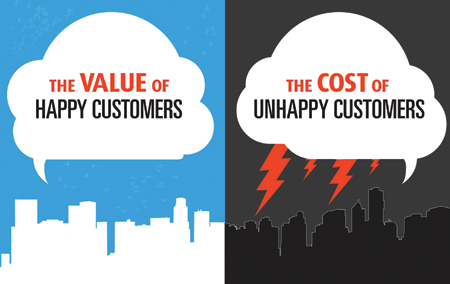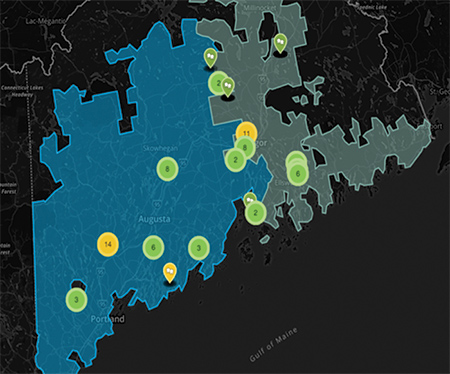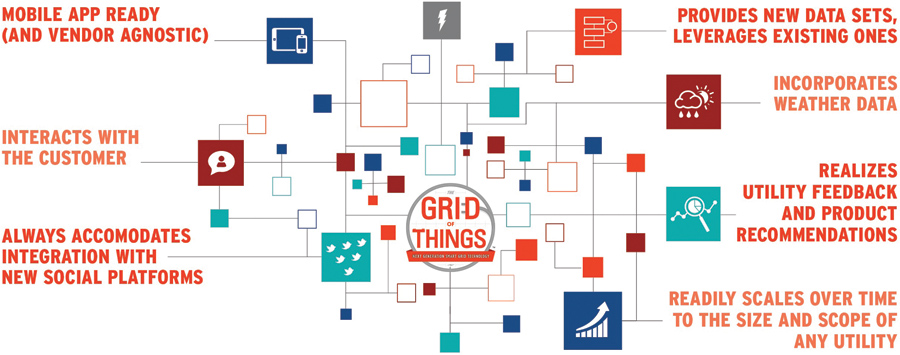“I want my toaster to talk to my Utility.” – Zac Canders, Co-Founder & CEO DataCapable.
While Zac’s statement drew more than a few chuckles among us here at DataCapable, he had a point: we’ve reached a time when technologies such as Toaster-to-Utility communications have moved from the realm of ‘possible’ to ‘inevitable.’
The next technological revolution is already here, and it’s collectively known as the ‘Internet of Things,’ ‘IoT,’ or ‘#IoT’ – depending on whether you’re respectively talking, bragging, or Tweeting about it. Regardless of the moniker, the Internet of Things is poised to change everything we know about the technology we interact with throughout our days. We give credit to Thomas Edison for building the foundation of today’s grid – lots of wires and poles. We recognize ‘Smart Grid’ as bringing network connectivity to devices – all those intelligent devices like smart meters, smart reclosers, smart thermostats. We’re now entering the era that power systems engineers have dreamt of for over a century, intelligently connecting all of these grid devices with each other.

Yet connectivity isn’t just happening within the grid. This new era of change for utilities is also a new era of connectivity for customers - ask any call center and the rhetoric will be the same; customers are mobile, social and they want instant updates when the power goes off. It doesn’t matter where you live or what language you speak. When a power outage occurs, customers want to be updated, on the platforms they prefer, and they want these updates fast.
Ten years ago, connections for a utility meant customers calling to report an event. In 2016, I spend a majority of my day working with utilities to show them how connections aren’t what they use to be, how the electrical grid has been combined with the telecommunications grid and how two new layers have emerged - the customer, and interoperable grids. It’s a connectivity journey that is changing how grid operators, engineers, and business leaders drive value from increasingly dynamic customers. It is the connectivity transformation that is building more meaningful relationships, new revenue streams for utilities and a truly connected grid.

Utilities are embracing the value of the customer. Together, the industry and those that support are just beginning to discover how a services-oriented utility can drive a deeper relationships and new efficiencies in the meter-to-cash business process.
Safety, reliability, and the customer are the core focus of any utility employee. In 2016, we must add interoperability. This changing customer dynamic, as we transition from the Baby Boomers to Generation X, and Millennials, speaks to a new mantra for every utility employee.
Interoperability of sensors, data, systems, telecommunications, protocol, utility teams, vendors, and the customer. It may seem like an insurmountable challenge, but without it, the true opportunity to save billions in energy efficiency, system integrations, and the end-to-end value from the generation station to the wall outlet will never be achieved.
The Internet of Things and its Connection to the Grid - How Do We Realize the Value?
Both myself and my colleagues see enormous potential in a complementary, utility-facing component to this new network – we call it the ‘Grid of Things,’ a solid foundation and innovative system of change that could affect all parts of the electrical grid (including, but not limited to, energy generation, transmission, and distribution). We believe we’re witnessing the convergence of Moore’s Law (that which computing power has doubled every year since its conception in 1965) and Metcalfe’s law (the value of a telecommunications network is proportional to the square of the number of connected users of the system); this convergence is rapidly propelling us towards the Grid of Things.
Our vision of the Grid of Things is an assembly of standardized web services & security protocols, robust software interfaces, open data formats, and supporting elements necessary for the seamless front-end and back-end connectivity of devices. The Grid of Things is the blueprint for true interoperability among devices, beginning with the power that brings them to life, and ending with Zac knowing his toast is going to be perfectly browned in the morning (because that’s how he likes it on Saturdays). The role of interoperability is just beginning to emerge.
Recent examples of the Grid of Things
Getting a bit more specific, the Grid of Things is primarily comprised of interoperable hyper-local devices (like toasters) along with associated data & metadata (for example, Zac’s personal preference for ‘toastiness,’ time of use; quantity; etc). The potential of front-end, consumer-facing interconnected technologies has already proven apparent with the introduction and adoption of devices such as the Nest thermostat and Roomba vacuum (and their associated consumer app interfaces).
At DistribuTECH 2016 two examples, EPRI’s Outage Data Initiative (ODI) and Duke Energy’s Coalition of the Willing both showcased how data from devices can be shared in real-time across utilities and vendors. Both required a simple set of rules, standards adoption and best practices software development.
The Outage Data Initiative: The first step towards interoperability between utilities and vendors began at the Application Layer with the Outage Data Initiative (ODI) working group. The Outage Data Initiative is a group of representatives from utilities and vendors that are interested in utilizing outage data from external sources. The group’s goal is to share outage data in a common format so it can be easily consumed by any software platform without custom integration time and costs. The result of this work was the ODI standard and was showcased at DistribuTECH 2016. By formatting the outage data into the standard that came from a device (a Raspberry PI in this scenario), it was shown how easily and quickly it can be consumed by a third party. Sharing data between neighboring utilities can help understand the potential impact of a storm as it approaches and provides a clear understanding of the crew that should be ready to handle the impact. Sharing the data with police and fire systems can aid with the help of people in need. DataCapable is one of the many industry leaders that is supporting the vision and development of the standard. Together we have shown that the safety and reliability of grid operators and customers will realize enormous efficiency gains just by leveraging interoperability during major storm events.

In a recent example of interoperability, two neighboring United States utilities showcased how standardization and sharing of outage data can enable value; proactive staging of crews, improved predictions of outage impacts from inclement weather, sharing of resources during times of natural disasters and inclement weather all become a reality just by embracing interoperability.
The Coalition of the Willing: is a partnership of over twenty teams representing universities, vendors, research labs, utilities, and governmental agencies to support the development and commercialization of field interoperability of smart grid devices and associated systems. The framework is called the Open Field Message Bus (Open FMB™) and it was showcased at DistribuTECH 2016. It is recognized as another example of interoperability activities happening in the grid. The value is that one-day grid operators, engineers, and third party developers can choose from a myriad of hardware and software options, share data faster across all parties, and enable efficiencies from distributed intelligence and renewables integration.
Together We (The Industry) Can Connect
The Grid of Things is a new area of opportunity for electrical utilities to maximize their investments, explore new value propositions, and embrace try-before-you-buy scenarios – all while passing the value back to their customers via the intelligent devices they own. By embracing best practices in web service development in conjunction with protocols connecting the data of one smart grid device or platform to another, I’m confident that the Internet of Things will reside on the solid foundation of the Grid of Things.
If you have an interoperability story to tell. Or these examples of interoperability inspired you, let us know. The customer and interoperable grid journey have just begun. Collaboration and standards adoption will take buy-in from all stakeholders in the utility industry. Together we can lay the cornerstones for the foundation of the Internet of Things: it all starts with the Grid of Things.
About the Author
 Ryan Zaczynski is DataCapable’s Data Science & Analytics Director. In this role, Mr. Zaczynski works with DataCapable’s engineering team and one of the world’s leading research universities on developing next generation analytics and machine learning algorithms for DataCapable’s platforms. He has experience across a diverse cross-section of industries in the areas of management, business analytics, and customer experience & support. Most recently Mr. Zaczynski has been involved in the standardization of outage data, and this work resulted in an invitation to meet with likeminded leaders at the United States White House.
Ryan Zaczynski is DataCapable’s Data Science & Analytics Director. In this role, Mr. Zaczynski works with DataCapable’s engineering team and one of the world’s leading research universities on developing next generation analytics and machine learning algorithms for DataCapable’s platforms. He has experience across a diverse cross-section of industries in the areas of management, business analytics, and customer experience & support. Most recently Mr. Zaczynski has been involved in the standardization of outage data, and this work resulted in an invitation to meet with likeminded leaders at the United States White House.








